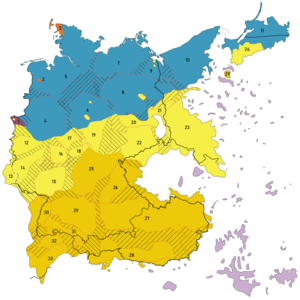High Prussian dialect
[1] It shares some features with Low Prussian, differentiating it from other Central German dialects east of the Germersheim line [de].
Based on those findings, Mitzka developed the theory that Central German settlers, whose arrival can be precisely determined by numerous tangible facts, left Mark Lausitz between 1290 and 1330, when political turmoils made settling in Prussia appear more attractive.
[4]: 65–67 Erhard Riemann tested Mitzka's theory using further toponymy and concluded that the material was not sufficient to allow a reliable location of the origin of High Prussian.
Since the expellees scattered throughout Western Germany (with some exceptions, like the Ermländer settlement on a former military training area in Heckenbach/Eifel) the dialects are now moribund.
[6] Most of the High Prussian speakers not expelled after World War II relocated from Poland to Western Germany in the 1970s and 1980s as so-called late repatriates (Spätaussiedler).
This area is almost identical to the portion of the former Prince-Bishopric of Ermland governed by the bishop, which settled it with Central German peasants.
[4]: 66–69 [1] Linguistic features in consonantism are:[2]: 121–124 Oberländisch was mainly spoken in the districts of Preußisch Holland and Mohrungen and in the adjacent area east of the Vistula.
According to Kuck and more recent Szulc the language of the former district of Rosenberg had a special subdialect of High Prussian, which they called Rosenbergisch.
[20] August Schemionek published the following anectode in 1881, in which the regiolect[citation needed] of Elbing is featured: Ein Elbinger kommt nach Dresden und frühstückt im Hotel auf seinem Zimmer, wobei ihm der Napf mit Sahne umfällt.
A man from Elbing visits Dresden and has breakfirst in his hotel room, when he spills his milk jug full of cream.
He rushes to the hallway, telling the room servie girl: "Dear madam, I have got a situation here, I have spilled cream and now it is splattered all over the napkin and the carpet.

